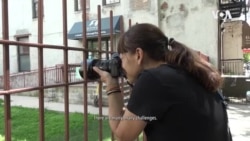((PKG)) CONNECTING THROUGH PHOTOJOURNALISM
((TRT: 7:00))
((Topic Banner: Connecting Through Photojournalism))
((Reporter/Camera: Aaron Fedor))
((Producer: Kathleen McLaughlin))
((Editor: Kyle Dubiel))
((Map: New York City, New York))
((Main character: 1 female))
((NATS/MUSIC)
((Adriana Zehbrauskas
Photojournalist))
Well, I went to journalism school. I always wanted to be a storyteller.
I think, in the end, I did not choose to be a photojournalist.
I think that was, kind of, photojournalism chose me.
((Courtesy: Adriana Zehbrauskas))
((Adriana Zehbrauskas
Photojournalist))
As a photojournalist, we cover many kinds of stories
but in the last 10 years I've pretty much dedicated myself to covering underrepresented communities. I was based in Mexico City
for 13 years. And there, I got to cover a lot of migration and a lot of the
violence that surrounded the drug wars. So, I did a lot of
work in Central America, Latin America. And now I'm based in
Phoenix. So, I'm following up with migration but on the other side of
the wall.
((NATS/MUSIC))
((Adriana Zehbrauskas
Photojournalist))
There are many, many challenges. First of all,
((Courtesy: Michael Frey))
your life is not
under any kind of schedule. You cannot schedule life
because,
you know, news just happen
((Courtesy: Adriana Zehbrauskas))
and you have to be ready to jump out of bed and, you know, fly to Haiti because there
was an earthquake. And so, it's a
challenge for your relationships, for your social life, because
you're always canceling things and…but, you know, people who know you and understand what you do will accept that.
((MUSIC))
((Courtesy: Adriana Zehbrauskas))
((Adriana Zehbrauskas
Photojournalist))
As a photojournalist, you cannot interfere with what's happening in front of you. And that means, you know, I'm not going to stage anything.
((Courtesy: Thomas Fuller))
I'm not going to ask people to do what they're doing. And I…but I have to be there
((Courtesy: Adriana Zehbrauskas))
and I have to be very close to them. And of course, you know, sometimes you relate a lot with
what people are going through. But I think that, you know, it'simportant to understand what's your role in there.
So, let's say I'm in Haiti and it's an earthquake and there's
a lot of injured people, although it's hard
for me just to watch it, I feel like it's important for me to take a step back and understand what is my
position.
My position is, my role in this situation is to document it
the best way I can to send the stories out and, you know, eventually get more help, get more organizations working
and try to be as a truthful observer as I can possibly be.
((Adriana Zehbrauskas
Photojournalist))
My work is a document. We document history.
((Courtesy: Michael Frey))
We document traditions, cultures. We preserve memory and
we expose issues.
((NATS: Adriana))
((Courtesy: Rafael Sanchez))
In a sense, you know…
((Adriana Zehbrauskas
Photojournalist))
I teach at a variety of places. I teach at a workshop called
the Foundry Photojournalism Workshop, which is a pro bono work that photojournalists do. We go
around the world and the goal here is to empower people to tell their own
stories.
((Courtesy: Rafael Sanchez))
I also teach at ICP New York,
International Center of Photography. I teach a weekend workshop for the documentary at the documentary program. And this semester, I taught
visual journalism at
((Courtesy: Adriana Zehbrauskas))
the Walter Cronkite School of
Journalism at Arizona State University.
((Courtesy: Rafael Sanchez))
((NATS: Adriana))
I will be pretty high up.
((Adriana Zehbrauskas
Photojournalist))
We teach them ethics. We teach them, you know, how to understand a story, how to translate this visually. And most of all, you know, the ethics of photojournalism.
((Courtesy: Adriana Zehbrauskas))
This is photographing people at their most vulnerable
moment is unfortunately one of, you know, the most common things we do in photojournalism.
((Adriana Zehbrauskas
Photojournalist))
Two years ago, I did a story for The New York Times.
We went to the border in Arizona,
((Courtesy: Adriana Zehbrauskas))
in Sasabe and we photographed some migrants that were
being deported.
((Adriana Zehbrauskas
Photojournalist))
And we photographed this man
((Courtesy: New York Times
Photographer: Adriana Zehbrauskas))
who was from Central America, and he had just been
deported like five minutes before. And he was calling his
mother. He was completely distressed. And this photo was
on the cover of The New York Times. And after that, they
stopped. And these people were being deported into
((Courtesy: Adriana Zehbrauskas))
this area that’s called Sasabe. And it's a very remote area and it's a very dangerous place on the Mexican side
that's dominated by the cartels. And it's a small town that
has no resources.
((Adriana Zehbrauskas
Photojournalist))
So, that was one of the images that resulted in them stop
being deported into that area.
((NATS/MUSIC))
((Courtesy: New York Times
Photographer: Adriana Zehbrauskas))
((Adriana Zehbrauskas
Photojournalist))
I believe that there are stories that have to be told even
when they, you know, the deadlines die down. There's so
many things I love about what I do, but I think what I love the most is this possibility of being with so many different people and situations, just to, you know, get into
people's homes and lives.
((Courtesy: Adriana Zehbrauskas))
And I think this, you know, and to do this, people have to
trust you. And this is something that I do not take lightly. I think I don't
take it for granted.
And I think it's a huge privilege to be able to witness and
share stories of other people.
((MUSIC))
((Courtesy: Michael Frey))











